-
Genealogy & Names
-
Tourist Information
-
Culture & Reference
CHRISTMAS GIFTS FROM IRELAND - VISIT IrishNation.com Only 358 Days To Go! |
|
February 2020 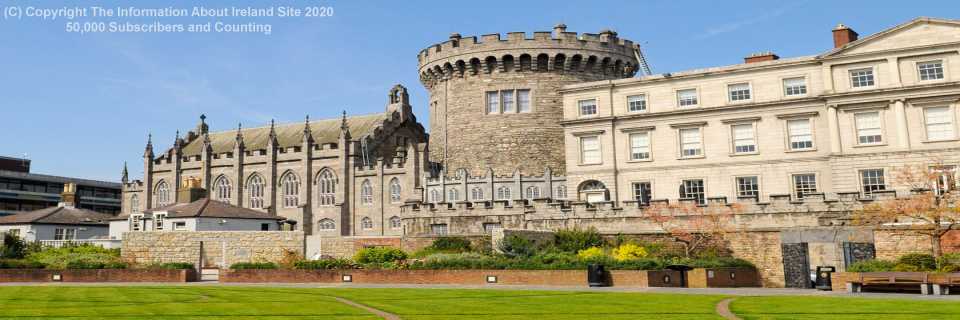
Dublin Castle image from Free Photos Of Ireland |


find out more |

| Popular Articles from Recent Newsletters: |


|
The recent General Election in Ireland was a triumph for Sinn Fein, with the Party increasing its share of the vote from 13.8% to 24.5% and increasing its number of T.D's (members of the Irish Parliament), from 23 to 37.  By contrast the election was a disaster for Fine Gael who won 35 seats and whose hopes for remaining in power were severely battered by the Irish voters. Their traditional rivals, Fianna Fail, did not fare much better winning 38 seats, as large swathes of voters turned to the more left-wing Sinn Fein, seeking out a change of direction for the country.
By contrast the election was a disaster for Fine Gael who won 35 seats and whose hopes for remaining in power were severely battered by the Irish voters. Their traditional rivals, Fianna Fail, did not fare much better winning 38 seats, as large swathes of voters turned to the more left-wing Sinn Fein, seeking out a change of direction for the country.
Despite the set-backs for Fine Gael and Fianna Fail, there remains a very real prospect that these two Parties my now have to form some manner of a Coalition Government, if only to prevent Sinn Fein from doing so. Both of these Parties have pledged to not enter into a coalition with Sinn Fein, thus leaving only each other as potential partners. For Sinn Fein the maths simply do not stack up. 80 T.D.'s are needed to form a stable Government and even a wide-ranging union of the various leftist Parties and independents would leave them short of that number. Simply put, if Fianna Fail and Fine Gael do not come together then a new General Election will have to be held, with the prospect of Sinn Fein increasing its advantage next time around. The annual Saint Patrick's Day celebrations in Ireland look certain to be very muted this year with the Government announcing that the main parades in Dublin and Cork have been cancelled. Other cities and towns in the country are expected to follow suit. The Covid-19 virus epidemic that is sweeping the world has resulted in these precautionary measures being decided upon, with further restrictions very likely to follow. |

|
The theft of the Irish Crown jewels – Star and Badge of the Order of St Patrick – is one of the most enigmatic episodes in our rich and chequered history. The mystery surrounds what was left out of the investigations as much as the discernible facts. 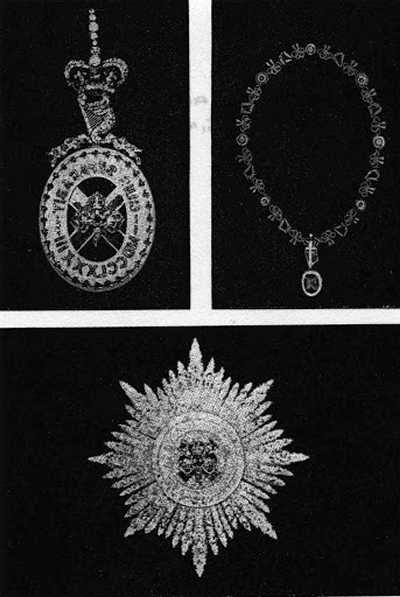 Presented to the Irish nation by William IV in the 19th century the jewels – almost 400 emeralds, rubies and diamonds – were not regally linked to the British monarchy (in fact there was no crown involved), but the Order of St Patrick, an elite aristocratic order founded in 1783. The collection was fashioned in the mould of the Order of the Garter in England and the Order of the Thistle in Scotland. They disappeared in July 1907 and were never recovered.
Presented to the Irish nation by William IV in the 19th century the jewels – almost 400 emeralds, rubies and diamonds – were not regally linked to the British monarchy (in fact there was no crown involved), but the Order of St Patrick, an elite aristocratic order founded in 1783. The collection was fashioned in the mould of the Order of the Garter in England and the Order of the Thistle in Scotland. They disappeared in July 1907 and were never recovered.
Suspicion naturally focused on the four men charged with their safety and when the dust of public scandal had finally settled their distinguished careers lay in ruins. This national treasure – valued in today's terms at $20 million – had been hitherto securely housed in a safe, deep within the confines of Dublin Castle's Bedford Tower library, in the Office of Arms (responsible for genealogy, heraldry and state regalia) and seemingly impervious to unauthorised access, let alone robbery. The heralds entrusted with this high office were chosen with great care and were well-connected socially: Sir Arthur Vicars, then Ulster King of Arms; his nephew, Pierce Gun Mahony; and his two assistants – Francis Shackleton and Francis Bennett Goldney. Francis Shackleton was a brother of the famous explorer, Ernest Shackleton. The facts and sequence of events were not disputed, and the conclusions left a lot to be desired in the eyes of the public, a view ultimately shared by the reigning monarch. On 28th June, 1907, Vicars reported that his key to the tower's main door had disappeared. Five days later a cleaner, Mrs Farrell, discovered the main door unlocked when she arrived for her daily duties. Then, on 6th July, she noticed something even more unusual...the door to the library had apparently been left open overnight. That same afternoon a castle porter named William Stivey entered the King of Arms room while Vicars and Mahony were examining the gold and enamel collar of the Order of St Patrick. Their reason for doing so has never been fully established, given their familiarity with the jewels. Vicars then gave the porter a safe key and told him to return the collar to its rightful place with the rest of the treasure. A few minutes later Stivey returned in a greatly agitated state, stammering that the safe was already open. Vicars pushed past him to make his own inspection before exclaiming 'My God, the jewels are gone!' Preliminary police investigation determined that the thief must have spent at least fifteen minutes carefully removing the precious stones from their settings. In addition there was a 24-hours police and military patrol outside, but within the castle's boundaries. It logically followed that he or she must have been someone so well known as to allay the suspicions of the castle staff. Surely not a crime to baffle a Poirot or Holmes and indeed before the month was out the special team from Scotland Yard had produced the name of their prime suspect. The report was suppressed and the Chief Inspector was recalled to London. Some three months later Edward VII demanded the resignations of those four directly responsible for the safety of the jewels. Vicars reacted perhaps predictably – with great moral outrage, and felt honour bound to stand his ground. He refused to even attend a special commission of enquiry set up the following January. Under the circumstances it's hardly surprising the commission found him guilty of negligence and ordered his dismissal as Ulster King of Arms. But the tragic affair was far from over for the disgraced heralds. Mahony was killed in a bizarre shooting accident – alone. Bennett Goldney died in a car accident, and Shackleton...whatever happened to him? Well, after being jailed for defrauding an old woman he served his term in prison and then vanished into obscurity. As for Vicars, he too, died mysteriously. He was found in the grounds of his home, Kilmorna House, in County Kerry, on 14th April, 1921, his body riddled with bullets. A hand-written note nearby was cryptic: 'I.R.A. Never Forgets'. A spokesman for the Irish Republican Army insisted, however, that they were not to blame. This view was upheld by the general public, most of whom believed that Vicars had been made a scapegoat by the British Government and was entirely innocent of any crime. To this day no light has ever been shed on the whereabouts of the stolen treasure... or the identity of the person believed by Scotland Yard to be responsible. |


find out more |

|
Dear old Professor of Large Animal Surgery, John Patrick O'Connor, somehow, he managed it. Without ever transgressing the terms of his teaching contract, which forbade any reference to religious (presumably here including spiritual) beliefs as well as political matters, he somehow managed to imbue in the most hard-hearted of us some seed of self-respect and, with it, a reverence for Life. 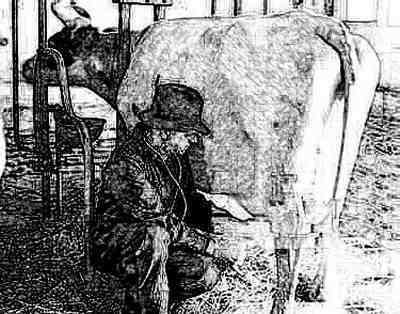 It has been said that faith can be caught, not taught. It certainly was hard to be around John without being inspired by him. It was the practice of a number of our final year lecturers to invite us students to their homes, one half of our 66-strong class at a time. Even then, I guess they strictly observed the no religion/philosophy/politics rule, but I was too shy to attend any such social event, and sadly absented my sad self.
It has been said that faith can be caught, not taught. It certainly was hard to be around John without being inspired by him. It was the practice of a number of our final year lecturers to invite us students to their homes, one half of our 66-strong class at a time. Even then, I guess they strictly observed the no religion/philosophy/politics rule, but I was too shy to attend any such social event, and sadly absented my sad self.
On one of those evenings, a friend told me, John advised students that, if ever they had any praise heaped upon them for any case, no matter how straightforward it had been, to try and bask in the glory for, in the unlikely event that they ever brought off some miraculous cure and earned due recognition, they could be fairly certain that they would not get it then. It was in the small hours of Saturday morning that I finally reached Brendan's farm to read the herd tuberculin test. Even now that I have learned how irrelevant the accuracy of my test results was to the elimination of bovine TB from Ireland's national cattle herd, I still feel uncomfortable about the number of times I read tests outside the 72 hours +/- 4 hours limit (or was it 3 back then?) prescribed by the Department of Agriculture, but, in a single-person practice, this was inevitable, at times. Late on Friday evening, I called Brendan to advise him I would be late and to beg him not to stay up. 'Mister Kelly, it doesn't matter in the slightest to me, you just come on ahead whenever it suits yourself, and I'll be waitin' for you!' 'No, really Brendan, it could be in the wee hours, and I know I'll manage fine myself...' 'Not at all, Mister Kelly, it's a matter of complete indifference to me how late you may come. I don't want you to be wrastlin' with them great big dangersome cows on your own. I'll be there!' 'Brendan, honestly, listen to me, if I think you'll be waiting up for me, it'll only put me under more pressure, really! Your cows are fine and quiet, I'll have no trouble. I'm begging you to please go bed and don't be waiting up! And if I do happen to need any help, I'll know where to find you, okay?' 'Very well then, Mister Kelly, but I wish you'd just give me a call whenever you arrive...' So I read and bled the herd without incident about two or three in the morning, and left a note for Brendan telling him that his cattle had all passed. About eight on Saturday morning, Brendan phones and leaves me a message, a message I kept for a long time and listened to often enough to memorize it almost verbatim. 'Well, Mister Kelly, it's Carlin here, Brendan Carlin from Burketown. I seen the note you were good enough to lave me, and I thank you kindly for it. I am verra grateful to you. And, Mister Kelly, I have to tell ya this, if that hadda been the First Worrald War, you'da been covered aal over with medals, so you would, an' I'da ben shot at dawn. You out there wrastlin' with them great big dangersome cows aal on your own, an' Carlin inside, rowlin' in the bed for himself....' Not long after, Brendan called back again, and I picked up. It struck me afterwards that he perhaps felt that I perhaps might have understood his message or taken it at face value, but thought it sarcastic, and that he was anxious to clarify. 'Well, Mister Kelly, I just wanted to tell ya that I am full of admiration for your devotion and dedication to duty so I am – you out there wrastlin' with them great dangersome cows, and no help at aal from me...' Try as I might, I could not bask in this glory. Partly, I knew that it was I the Department might have shot at dawn if they knew my habit of out-of-hours reading. Partly, I knew that, at the end of the day, the only person worth impressing...is oneself. But, in any case, that TB test served to deepen the bond of mutual respect and friendship between Brendan and me, and that is something I've treasured. |

|
||||

|
After the 1845 to 1849 Irish Famine emigration soared with as many as a million native Irish leaving their homes in the decades after the famine to settle in places like Boston, New York, Newfoundland, Perth, Sydney and beyond. The US Census Bureau now reports that 34 Million US Citizens claim Irish descent. Most emigrants like to commemorate their heritage and thus the Saint Patrick's Day Parade came into being. 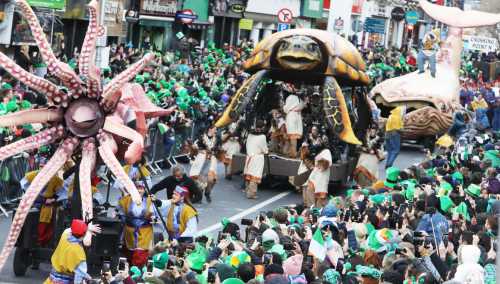
The earliest record of a Saint Patrick's Day Parade was in the year 1762 when Irish soldiers serving in the British Army held a Parade in New York City. Earlier records suggest that the day was celebrated by the Irish in Ireland as early as the ninth and tenth centuries. Again, this was a very difficult time in Irish history with Viking raiders terrorizing the native Gaelic population. It is thus no surprise then that in times of strife the local population would turn to religion and to a commemoration of their own heritage and individuality - a practice that has been repeated by populations of troubled places since the dawn of time. The New York Parade is now the longest running civilian Parade in the world with as many as three Million spectators watching the Parade of over 150,000 participants. 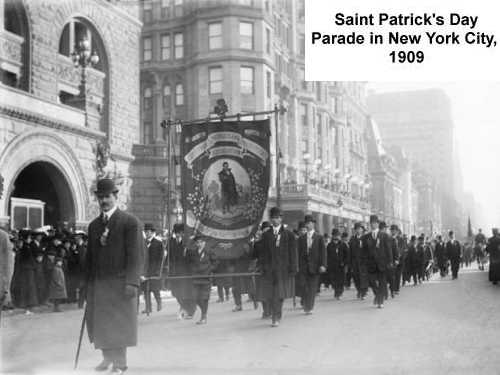
The first official Parade in Ireland was in 1931. The 1901 law that copper-fastened March 17th as an Irish national holiday was later amended to insist that public houses close down on the day. This restriction was later lifted in the 1970's. In the mid 1990's the Irish Government really started to promote the event when it changed from a single day's Parade into a 5-day festival attracting as many as a million visitors into the country. Parades are now held in just about every major city in the world with the biggest in several US cities reaching epic proportions. THE WEARING OF THE GREEN The tradition of wearing Shamrock to celebrate Saint Patrick seems to date from the seventeenth or eighteenth century. This was a very turbulent time in Irish history. The suppression of the Gaelic way of life by the ruling British invaders resulted in many aspects of the Catholic religion in Ireland being forced underground. Strict laws were enforced which prevented the Catholic population from attending schools so 'hedge-schools' were operated in secret. 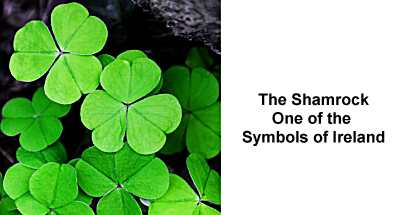
These were schools run outdoors in secluded places (sometimes literally 'under a hedge!). The teaching of religion was also forbidden so it is only to be expected that teachers would use naturally available resources to inform their pupils. Thus the Shamrock plant was used to illustrate the message of the Christian Holy Trinity. Saint Patrick was credited with using the Shamrock in such a manner so the wearing of the Shamrock by the oppressed Catholic population became a means of demonstrating their defiance to the ruling British class. It also imbued a sense of kinship among the native Gaelic people, differentiating them from their oppressors. Wearing a clump of Shamrock is now a firmly established tradition throughout the world to celebrate not just Saint Patrick but Ireland itself. The Shamrock symbol is widely used by businesses seeking to associate with Ireland and, along with the Harp, is perhaps the single most recognizable symbol of Ireland. It is a shame though that the Shamrock is not a blue plant as the color originally associated with Saint Patrick was blue! GREENING OF BUILDINGS AND RIVERS The use of the color green reached new heights (or plunged new depths!) when in 1962 the city of Chicago decided to dye part of the Chicago River green. Since then the campaign to have just about every possible landmark turned green for the day has taken off in earnest. 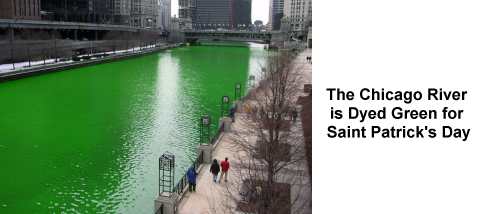
In recent years this has included the Irish Parliament building, the Sydney Opera House, the Empire State Building, Niagara Falls and even the Pyramids of Giza in Egypt! A PINT OF PLAIN The Irish association with drinking is well known and not always positive. Fortunately there are plenty of examples of the appropriate use of alcohol and Saint Patrick's Day is one of them. It is a widely held tradition in Ireland that beer or whiskey can be taken on Saint Patrick's Day although native Irish pub-goers can only look on aghast as visitors top the heads of their creamy pint of Guinness with a green Shamrock. Sacrilege! It is estimated that as many as 13 Million pints of Guinness are consumed on Saint Patrick's Day, up from the usual 5.5 Million per day! 
DRESSING UP The tradition of dressing up in Irish outfits is not just confined to participants in Parades. Jovial creatures of Irish origin the world over use the opportunity of Saint Patrick's Day to dress up as Leprechaun or even as Saint Patrick himself. Kids love to wear the big green, white and orange hats and receive sweets thrown to them by similarly clad operators of the various Parade floats. THE SAINT PATRICK'S DAY DINNER Corned beef and cabbage is as traditional and Irish meal as you will ever find and it is often hauled out for Saint Patrick's Day. Traditional Irish music in the background and a family gathering are other Irish Saint Patrick's Day traditions that have been going on for centuries. 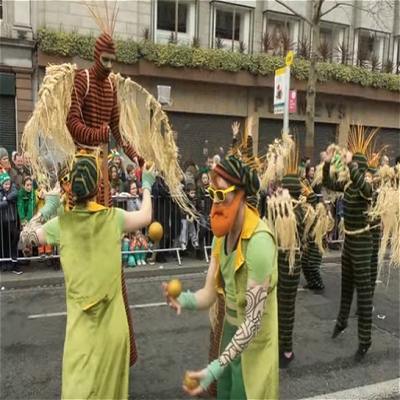
View a Video of the Dublin St. Patrick's Day Parade in action. |

|
FREE IRISH SONGS EBOOK Lyrics and Music to 74 of Ireland's most popular songs. Go Here IRISH LANGUAGE PHRASES Hundreds of Gaelic Phrases with Pronunciation Guide. Go Here FREE IRISH RECIPES EBOOK 25 of the very best Irish Recipes for you to mess up. Go Here SAINT PATRICK'S DAY TRADITIONS Wear some green, march in a parade, maybe have a pint! Go Here KIDS GAMES: LEARN ABOUT SAINT PATRICK AND IRELAND Simple coloring sheets and easy quizzes for kids. Go Here READ ABOUT THE LIFE OF SAINT PATRICK He was British, we know, enough already. Go Here FREE ST. PATRICK SCREENSAVER Download the Free Saint Patrick's Day Screensaver. Go Here VIEW YOUR IRISH FAMILY CREST 1000 Images and Name Histories Go Here |

View the Archive of Irish Phrases here: http://www.ireland-information.com/irishphrases.htm |

|
The winner was: megankearneyillustrator@hotmail.com who will receive the following: A Single Family Crest Print (usually US$24.99) Send us an email to claim your print, and well done! Remember that all subscribers to this newsletter are automatically entered into the competition every time. I hope that you have enjoyed this issue! 
by Michael Green, Editor, The Information about Ireland Site. http://www.ireland-information.com Contact us (C) Copyright - The Information about Ireland Site, 2019. 17 Páirc Ghrainbhil, Carraig Dubh, Contae Baile átha Cliath, Ireland Tel: 353 1 2893860 |

|
MARVELOUS GIFTS FOR ANY OCCASION FREE DELIVERY TO YOUR DOOR 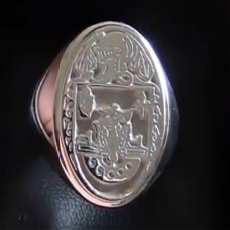
BIG REDUCTIONS! Stunning Family Crest Signet and Seal Rings 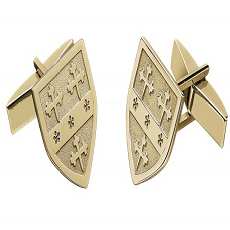
DISCOUNTED FOR A LIMITED TIME Elegant Cufflinks 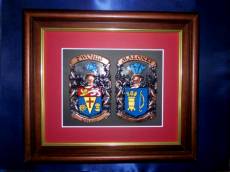
Incredible Family Crest Plaques Made in Ireland 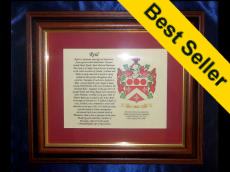
Superior Framed Family Crest Parchments 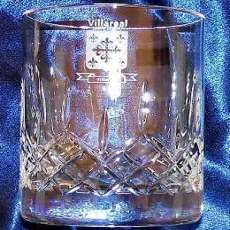
Gorgeous Glistening Galway Crystal 'Your-Name' Old Irish Sign NEW DESIGNS! 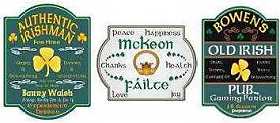
From US$34.99 - Free Delivery 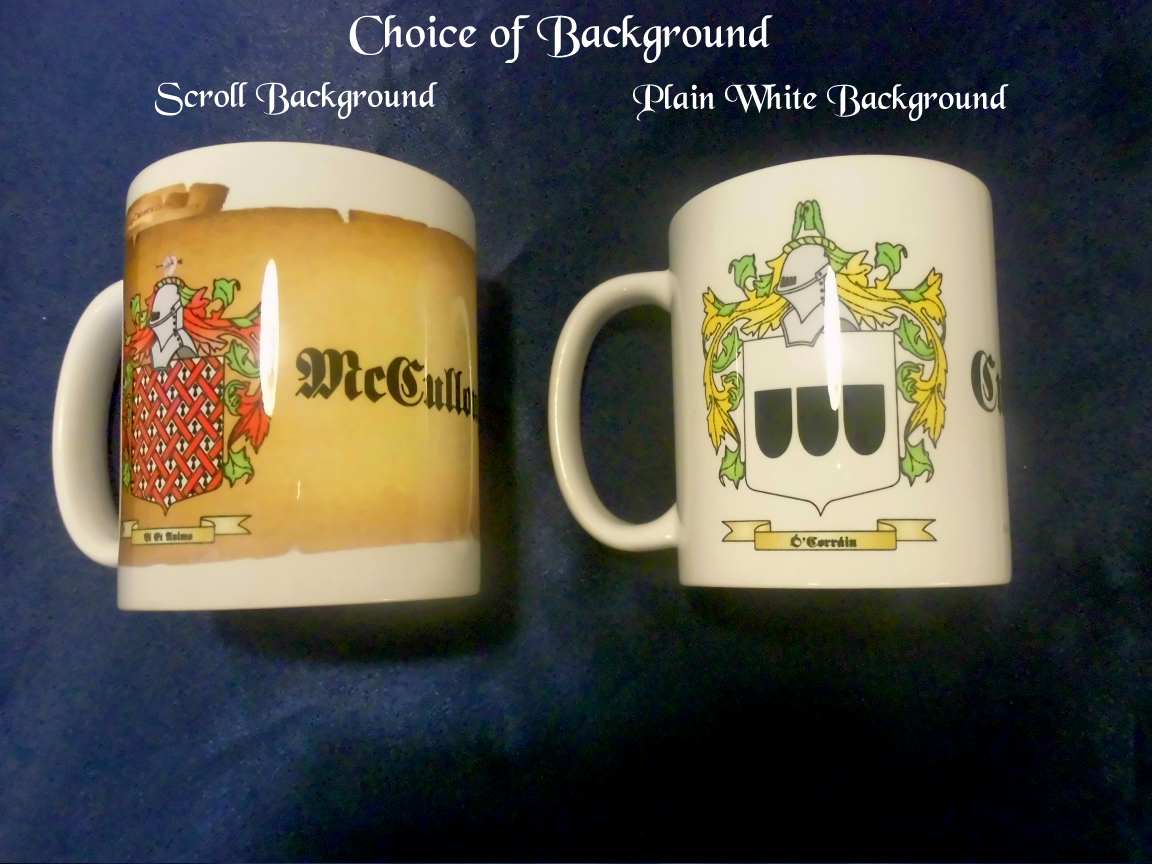
New Designs available on our Coffee Mugs 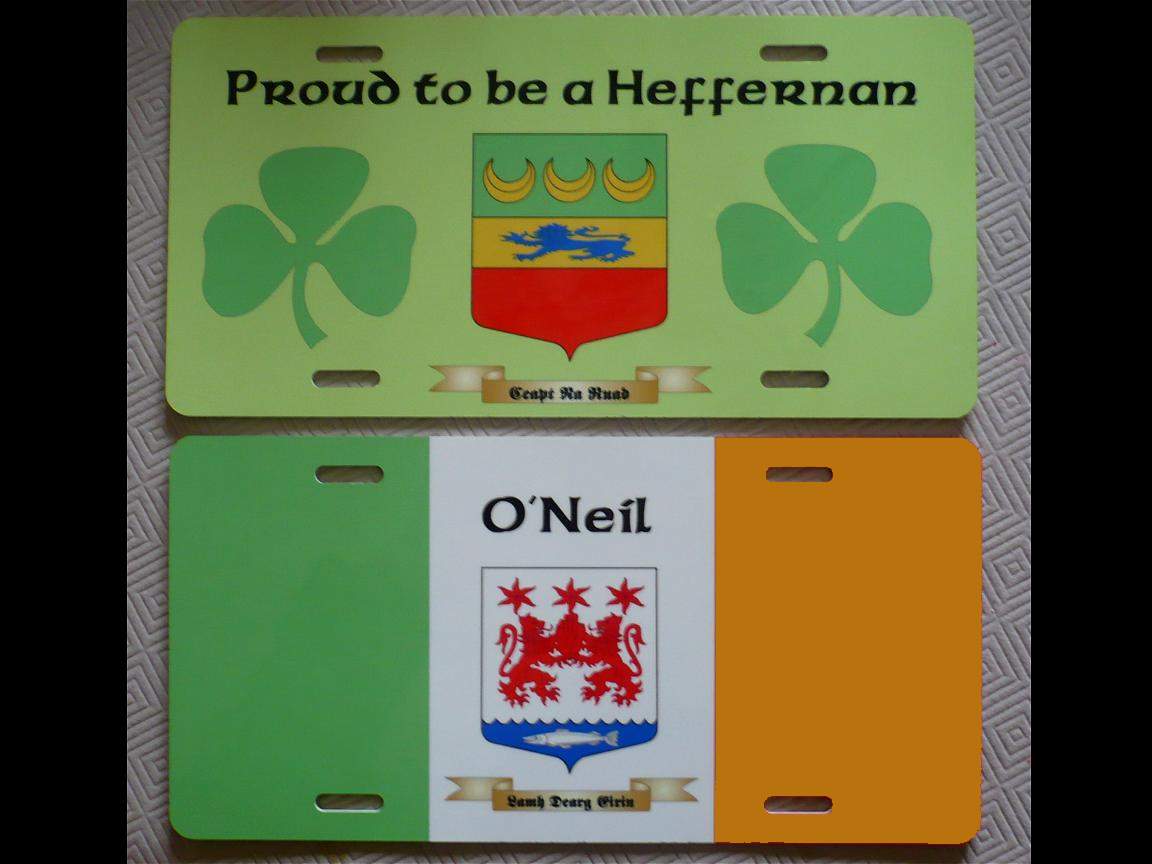
Personalized Licence Plate 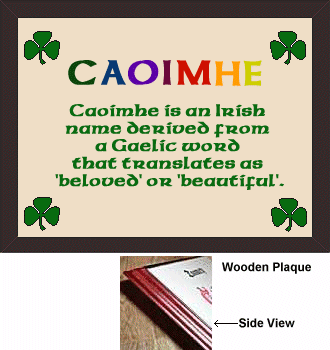
Personalized First Name Plaque. Great for Kids! 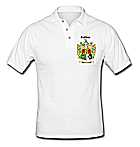
'Your-Name' Polo & Tee Shirts 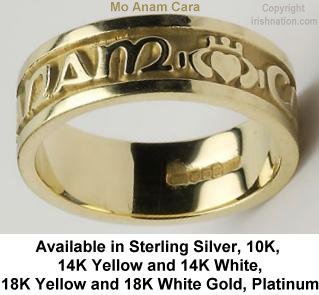
From US$69 Delivered BIG REDUCTIONS! Stunning Engraved Rings from Ireland with Irish Language Phrases. Mo Anam Cara: My Soul Mate Gra Dilseacht Cairdeas: Love, Loyalty, Friendship Gra Go Deo: Love Forever Gra Geal Mo Chroi: Bright Love of my Heart SEE MORE GREAT OFFERS AND DISCOUNTS AT: IRISHNATION.COM FREE DELIVERY FOR A LIMITED TIME! |
